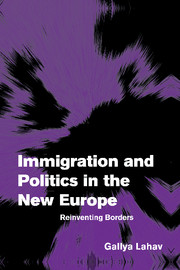Book contents
- Frontmatter
- Contents
- List of figures and tables
- Preface and acknowledgments
- 1 Introduction
- 2 Toward a people's Europe: an institutional analysis of immigration policy in the European Union
- 3 An attitudinal portrait of a people's Europe: a comparative overview of public opinion and elite preferences
- 4 Immigration politics and the new Europe: organizing competing interests
- 5 The “European factor”: institutional and psychological constraints on immigration attitudes
- 6 Conclusions: the construction of a European immigration regime?
- Appendices
- Bibliography
- Index
1 - Introduction
Published online by Cambridge University Press: 18 December 2009
- Frontmatter
- Contents
- List of figures and tables
- Preface and acknowledgments
- 1 Introduction
- 2 Toward a people's Europe: an institutional analysis of immigration policy in the European Union
- 3 An attitudinal portrait of a people's Europe: a comparative overview of public opinion and elite preferences
- 4 Immigration politics and the new Europe: organizing competing interests
- 5 The “European factor”: institutional and psychological constraints on immigration attitudes
- 6 Conclusions: the construction of a European immigration regime?
- Appendices
- Bibliography
- Index
Summary
Act I, Scene 1: Young dark immigrant boy crosses a bustling city street. As he briskly turns the corner, in front of a kiosk selling newspapers in thirty-five languages, he stops to look up at the European Parliament's new age glass skyscraper that honors Europe's citizens. For the moment, his eyes miss the pop-art covered wall in front of him. Slashing across it, red painted words scream, “Immigrés Dehors!” [“Immigrants Out!”]
(Diary of researcher, Brussels, June 1993.)Scene 2: In neighboring France, where the European Parliament meets, ideals of “égalité” seem to collide with immigrant realities. Strasbourg, a city of 250,000, is the European Union's capital. It is also home to 14 percent of France's foreign residents, 10 percent unemployment, and a substantial (26 percent of Front National vote) anti-immigrant party.
(New York Times, 23 March 1997.)Approximately 25 percent of the world's migrants (15 million “foreigners”) reside in Europe today. European policy-makers are forced to deal with this reality and the increasing agitation of their indigenous publics. What was once a bureaucratic and post-World War II phenomenon tied largely to reconstruction needs, the introduction of culturally, religiously, and ethnically diverse groups into European society has had an impact in the public and political arenas. This has been marked by electoral campaigns and party contestation, the emergence and consolidation of extreme-right parties, and increasing public support for xenophobic political forces.
- Type
- Chapter
- Information
- Immigration and Politics in the New EuropeReinventing Borders, pp. 1 - 25Publisher: Cambridge University PressPrint publication year: 2004

